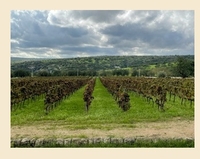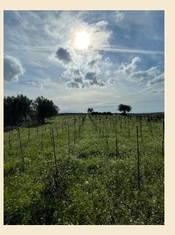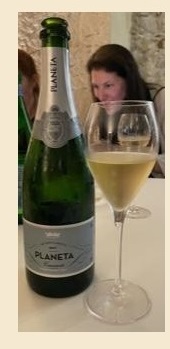After almost two years of having my travel opportunities limited to my home state of California, I jumped at the chance to slide through what—as of this date—appears likely to have been a very narrow opening to get away to the enchanted isle of Sicily for a deep dive into the relatively new Sicilia (“Si-CHEE-lee-ah”) DOC. I’m pleased to report that what I found is a treasure trove of delicious wines of all colors and styles that deliver extreme quality for their modest pricing. I’ll divide my coverage into a couple of columns – this one focused on the particulars of the DOC itself, and the next getting into specific wines and producers worth seeking out.
First a quick primer/reminder about Italian wine law. The gradation system includes four different levels: Vino di Tavola (VdT), which generally includes wines of no particular pedigree that are meant to be economical daily drinkers that rarely get exported; Denominazione di Origine Controllata (DOC), wines that adhere to specific production protocols including grape varieties used, vineyard yields, minimum alcohol levels, and barrel and/or bottle aging requirements; Denominazione di Origine Controllata e Garantita (DOCG), wines that kick the DOC requirements (and often pricing) up a notch (think noble wines like Barolo, Brunello di Montalcino, Chianti Classico) that are guaranteed to be of “high quality” by a government tasting panel, and finally, Indicazione Geografica Tipica, or IGT (or IGP under the European Union umbrella), which generally includes wines that go outside the scope of DOC requirements while remaining typical of their region across a wide range of quality levels.

The Sicilia DOC designation was bestowed in 2011, and it encompasses the entire island’s 9900 plus square miles, which is somewhere between the size of Vermont and Massachusetts. Within that space there are 24 DOC’s and one DOCG, and producers may choose to combine the sub-DOC on their labels – a wise play that can help stamp identity, i.e., Sicilia Menfi DOC rather than just the Menfi DOC, similar to Sonoma County’s smart requirement that sub-AVAs must also list Sonoma County on their labels, serving to orient consumers while simultaneously branding the entire region. Bravo! Not that I’m for more stuff on front labels, but when it is particularly useful for both producers and consumers, I’m all in.
The region has over twenty-three thousand hectares (58,000+ acres) under vine, nearly eight thousand growers, and about five hundred producers whose talents combine to create over ninety million bottles annually at present. There is a notable move among several producers to propagate and cultivate what they call Sicily’s “forgotten varieties” - types where maybe only a vine or two existed until recent attempts to revive them. Production is already underway – we visited a producer who has dedicated a corner of his vineyard to some of these forgotten varieties to see what might be lurking there, and produced two vintages of a white blend thus far. I’ll get into the specifics on that particular wine in the next column, but for now I’ll say that, though the vintner thus far has found the micro vinifications of the individual varieties somewhat uninteresting, the blended “orchestra” shows great promise.

The focus of Sicilia DOC is twofold: the consorzio aims to lift the visibility of Sicilian wines in general in the international marketplace, and to enhance the standing of two particular grape varieties. While there are 70 different varieties being cultivated on the island, the group decided on Nero D’Avola and Grillo as the varieties that can put the best foot forward on the whole. The two grapes seem to have the ability to show their core characteristics across a range of styles while also showing qualities that are distinct to specific sub regions. That commitment goes so far as to say that if a wine is named (varietally labeled) as either Nero D’Avola or Grillo, it must also be labeled Sicilia DOC and meet the specifications thereof.
I can hear some of you shaking your heads already: “Isn’t Nero D’Avola that black devil that is always overripe, overwrought and generally indistinct full throttle red?” The answer is a hearty “not so much anymore,” thanks to the DOC’s work in showing that it doesn’t have to be that way at all. The island’s highest production grape can show a real complexity of aromatics and flavor development when yields are managed and harvested at higher total acidity and lower pH numbers. Typical characteristics include mixed berries, cherry, wildflowers, violets, tea, tobacco and chocolate. Tasting through samples reminded me of the wide array of possibilities with Pinot Noir or Zinfandel in California, with microclimates playing a critical role in what ends up in your glass.
On the white side, Grillo was chosen as the best representative of the DOC at large, though it is not the most widely planted variety among the whites. That crown goes to Catarratto, but the consorzio agreed that Grillo was the best choice as the “crown jewel” white variety for its ability to, like Nero D’Avola, maintain its inherent character while allowing subregional elements to speak in the glass. A cross of Catarratto and Zibibbo (Muscat), Grillo was originally developed to lift the aromatics of Marsala, perhaps the island’s best-known product which is undergoing its own renaissance. On its own, it is generally being made in a reductive style (low to no oxygen exposure during winemaking) with no malolactic fermentation and up to six months of lees contact. Grillo’s core characteristics include mixed citrus, mild herbaceousness, floral tones and saline notes that play off the fruit and flowers nicely. A tasting of several examples revealed a range in aromas and flavors that ran from Chardonnay-like all the way to having some similarities to Riesling. Our tour guide Filippo Bartolotta explained that the core characteristics remain present, but that the DOC is more interested in letting vinification and site specifics take the lead in expression.

Among the other varieties found on the Island, a few are making their presence known in varietally labeled bottlings, some of which carry the DOC marque, and others that remain IGT or carry their own sub-DOC appellations. They include Carricante, which can make excellent sparkling wine; Inzolia, a white grape also known as Airen or Clairette; Zibibbo (a.k.a. Muscat d’Alessandria); Perricone, a thick skinned tannic red; Nocera, and ancient red variety; and Frappato (a milder red grape that can make elegant medium to light bodied wines of great depth). I tasted a spectacular Frappato as part of our journey – easily my “wine of the trip.” Frappato makes up 30-50% of the island’s only DOCG – Cerasuolo di Vittoria – at present, and it wouldn’t surprise me if it plays a role in the next DOCG to be designated. Notably absent from this list is Nerello Mascalese, the red heart of the Etna Rosso DOC, which currently opts to celebrate itself as distinct from Sicilia DOC. The system in Italy is in constant flux, so who knows what the future holds.
Perhaps the most amazing thing about the Sicilia DOC is its extreme value placement in the wine world. Out of the fifty or so wines I tasted over three days, only a small handful were priced over twenty dollars. The focus on value for your money coupled with the pioneering spirit of the consorzio adds up to wines that are worth seeking out. Stay tuned over the next several weeks for individual reviews of the best of what I tasted, and in my next column we’ll take a detailed look at a couple of producers. In the meanwhile, Saluti!